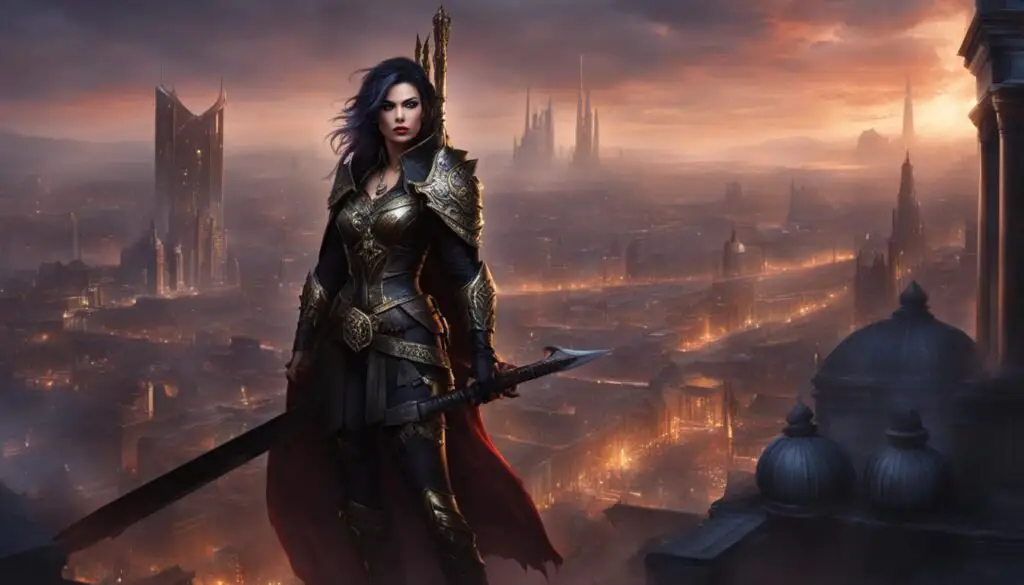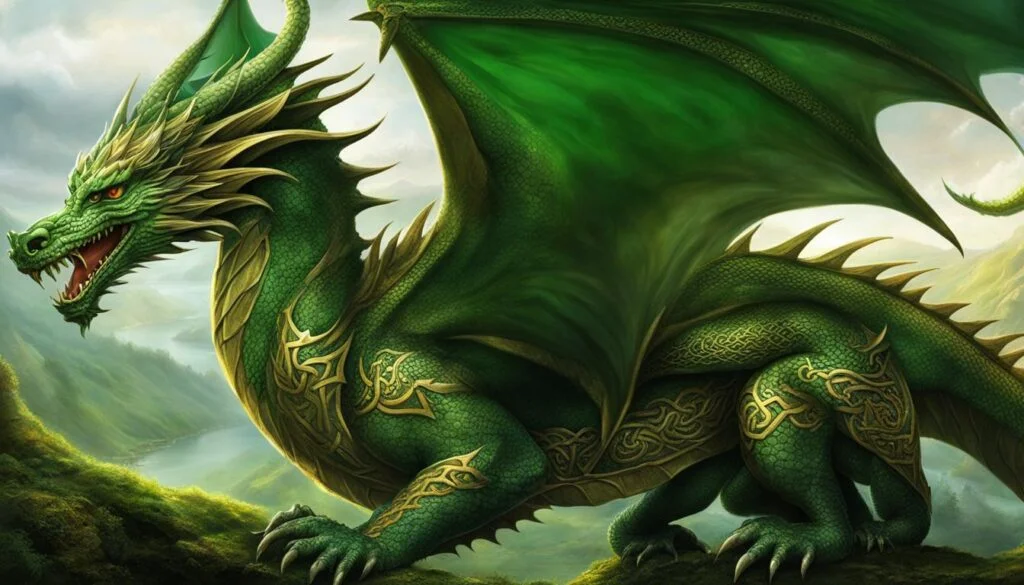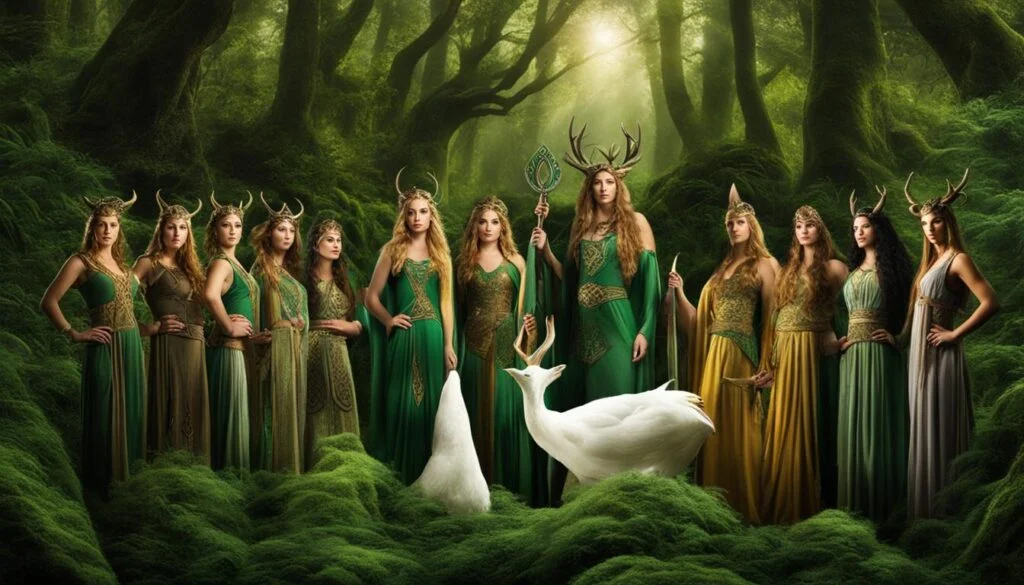In Celtic mythology, the goddess Morrigan is a powerful figure associated with war, death, and prophecy. Also known as the Phantom Queen, she is a shape-shifter who often takes the form of a crow. The Morrigan is often considered a collective entity, consisting of the three sisters Badb, Macha, and Nemain. However, there is variation in the identities and interpretations of these sisters in different versions of Irish mythology. The Morrigan plays significant roles in various myths and legends, interacting with mythical heroes and foretelling outcomes of battles. Her presence continues to inspire modern creative works, such as music, movies, video games, and books.
Key Takeaways:
- The Morrigan is a powerful goddess in Celtic mythology associated with war, death, and prophecy.
- She is often depicted as a shape-shifting crow and a collective entity consisting of the three sisters Badb, Macha, and Nemain.
- The Morrigan plays significant roles in various myths and legends, interacting with mythical heroes and foretelling outcomes of battles.
- Her influence can be seen in modern creative works, such as music, movies, video games, and books.
- The Morrigan continues to fascinate and inspire with her mysterious and enigmatic nature.
The Three Sisters: Badb, Macha, and Nemain
The Three Sisters: Badb, Macha, and Nemain
The Morrigan, an intriguing figure in Celtic mythology, is often represented as a trio of sisters known as “the three Morrígna”: Badb, Macha, and Nemain. Each sister brings her unique essence to the mythological landscape.
Badb – The Terrifying Battle Cry
Badb, associated with the crow and witchcraft, strikes fear into the hearts of warriors with her powerful battle cry. Her piercing voice echoes across the battlefield, instilling terror in those who hear it. Badb Catha, as she is sometimes called, possesses symbols such as the crow, the sickle, and the cauldron.
Macha – The Sovereign Protector
Macha, the goddess of sovereignty and land, embodies the spirit of the Celtic horse goddess. She is revered as a protector of sacred sites and holds a significant role in the mythology. Some symbols associated with Macha include items in red, the acorn, the mare, and even the severed head. Her presence reflects the intricate connection between power, land, and sovereignty.
Nemain – The Figure of Battlefield Terror
Nemain, the embodiment of terror on the battlefield, elicits fear through her imposing presence and bone-chilling shrieks. As warriors face her, their courage waivers, and chaos ensues. Nemain’s symbols encompass poison, the eerie shriek itself, and the sling-stone. She represents the relentless force in battle, leaving a lasting impact on all who encounter her.
Together, Badb, Macha, and Nemain embody the various aspects of war, sovereignty, and fear associated with the Morrigan. Their individual traits and symbols contribute to the rich tapestry of Celtic mythology and the enduring allure of these intriguing goddesses.
The Morrigan in Mythological Tales
The Morrigan, a powerful figure in Celtic mythology, features prominently in various myths and legends. Her stories often revolve around battles, fate, and death, intertwining with legendary figures in Irish mythology. Let’s explore some of the significant tales that showcase the Morrigan’s role as a harbinger of destiny and her interactions with key characters.
The First Battle of Mag Tuired
In the First Battle of Mag Tuired, the Morrigan and the Tuatha Dé Danann, a mythical race of gods, fought against the Fir Bolg, an ancient Irish tribe. The Morrigan used her magical powers to terrify the Fir Bolg warriors, inspiring fear and uncertainty among their ranks. Through her involvement in this battle, the Morrigan showcased her influence over warfare and her ability to shape the outcome of conflicts.
The Táin Bó Cúailnge
One of the most famous tales in Irish mythology, The Táin Bó Cúailnge, features the Morrigan as a key player. In this epic saga, the Morrigan opposes Queen Medb and her army’s attempt to raid the cattle of Ulster. She supports the hero Cú Chulainn, providing assistance and guidance as he defends his homeland. The Morrigan’s involvement emphasizes her role as a protector and ally to those who seek to uphold justice and defend their people.
Togail Bruidne Dá Derga
In the mythological tale Togail Bruidne Dá Derga, the Morrigan plays a crucial role in prophesying the downfall of Conaire Mór, the High King of Ireland. Her foreboding predictions foreshadow the tragic fate that awaits the king, highlighting the Morrigan’s connection to fate and her ability to foresee the outcome of events. This tale showcases her mysterious and mystical nature, as well as her association with both death and prophecy.
These myths and legends demonstrate the Morrigan’s pervasive presence in Irish mythology and the significant roles she plays in shaping the fates of legendary figures. As we delve deeper into the rich tapestry of Celtic folklore, the enigma surrounding the Morrigan only grows, captivating our imagination and sparking curiosity about this complex goddess of war, fate, and death.
The Morrigan in Contemporary Culture

The presence of the Morrigan as a powerful and enigmatic goddess extends to various forms of contemporary culture, showcasing her enduring influence and fascination.
Morrigan in Music
In the realm of music, the Morrigan’s association with war and death is captured in powerful compositions such as “Morrigan” by Children of Bodom and “The Morrigan’s Call” by Cruachan. These songs evoke a sense of mysticism and darkness, reflecting the goddess’s formidable nature.
Morrigan in Movies and TV Shows
The Morrigan’s influence can be seen in popular movies and TV shows, where she is depicted in various roles that highlight her multifaceted character. In “The Crow,” “Charmed,” “Lost Girl,” and “American Gods,” the Morrigan is portrayed as a source of resurrection, evil, leadership, and fading power. These appearances add depth and intrigue to the storylines, exploring different facets of the goddess’s persona.
Morrigan in Video Games
The Morrigan’s captivating presence extends to the realm of video games, where she is incorporated as a character with unique abilities. Games such as “Dragon Age: Origins,” “Smite,” and “Hellblade: Senua’s Sacrifice” allow players to interact with the Morrigan in immersive storylines, further emphasizing her role as a powerful and enigmatic figure.
Morrigan in Books
Authors have also been inspired by the Morrigan, incorporating her into various literary works. Christopher Moore’s novels “Dirty Job” and “The Wicked + The Divine” feature the Morrigan as an antagonist or a god reincarnated. These books explore the goddess’s complexities and her impact on the characters and plot.
Through her representation in music, movies, TV shows, video games, and books, the Morrigan continues to captivate audiences with her mysterious allure, cementing her status as a compelling figure in contemporary culture.
The Mystery of the Sphinx: History, Symbolism, and Representations

The Sphinx, an iconic creature from Greek mythology, finds its origins in the ancient Egyptian context. The Sphinx at Giza, believed to be associated with the pharaoh Khafre, is a remarkable structure carved out of a single piece of limestone. It features the body of a lion and the head of a human. This enigmatic creature played a significant role in ancient Egyptian beliefs, serving as a guardian and protector of sacred places.
In Greek and Roman mythological literature, the Sphinx is known for its riddles, devouring those who cannot answer correctly. The Sphinx has also been depicted in ancient Egyptian art, inspiring artists and writers throughout history. This magnificent monument continues to captivate the imagination and evoke a sense of mystery.
The age and purpose of the Sphinx elicit ongoing debates and theories. Scholars and researchers strive to uncover its true origins and meanings. Efforts are made to conserve and preserve this extraordinary monument, which remains a popular tourist attraction, garnering interest from visitors worldwide.
Key Features and Interpretations of the Sphinx
- The Sphinx at Giza represents a blend of human and animal forms, symbolizing the union of wisdom and strength.
- Various interpretations attribute different symbolic meanings to the Sphinx, including protection, divine royalty, and the balance between earthly and celestial realms.
- It is speculated that the Sphinx played a crucial role in ancient Egyptian beliefs, acting as a guardian of the pyramids and temples.
- The presence of the Sphinx in Greek mythology showcases the influence and appropriation of ancient Egyptian culture by other civilizations.
The Sphinx’s intricate history and symbolism continue to pique the interest of historians, archaeologists, and enthusiasts alike. It serves as a testament to the rich cultural heritage of ancient Egypt and the enduring allure of mythological creatures.
Conclusion
In Celtic mythology, the Morrigan is a fascinating and complex goddess associated with war, death, and prophecy. Often depicted as a trio of sisters, the Morrigan plays a prominent role in various myths and legends. Her influence extends beyond ancient tales, permeating modern culture through music, movies, TV shows, video games, and books.
On the other hand, the Sphinx, a mysterious creature from ancient Egyptian mythology, holds significant cultural and religious importance. With its intriguing history, construction, and symbolism, the Sphinx continues to captivate historians and visitors alike.
Although the Morrigan and the Sphinx originate from different mythologies, they both embody the enduring allure and fascination surrounding mythological creatures. Celtic mythology and ancient Egyptian mythology offer glimpses into the rich tapestry of human imagination and belief.
FAQ
Who is Morrigan in Celtic mythology?
Morrigan is a powerful figure associated with war, death, and prophecy in Celtic mythology. She is often depicted as a shape-shifting goddess who takes the form of a crow.
What are the three sisters associated with the Morrigan?
The three sisters associated with the Morrigan are Badb, Macha, and Nemain. They each have their own unique symbols and attributes.
What role does the Morrigan play in mythological tales?
The Morrigan features prominently in various myths and legends, where she interacts with mythical heroes and foretells outcomes of battles. Her presence signifies fate, battle, and death.
How does the Morrigan influence contemporary culture?
The Morrigan’s influence extends to music, movies, TV shows, video games, and books, where she is often portrayed as a source of resurrection, evil, leadership, and fading power.
What is the history and symbolism of the Sphinx?
The Sphinx has origins in ancient Egyptian beliefs and is known as a guardian and protector of sacred places. In Greek and Roman mythologies, it is famous for posing riddles to devour those who answer incorrectly.
What are some theories and debates surrounding the Sphinx?
The age, purpose, and construction of the Sphinx remain subjects of debate and ongoing research. Conservation efforts are made to preserve this incredible monument.
What do the Morrigan and the Sphinx represent in mythology?
The Morrigan and the Sphinx represent the enduring allure and fascination of mythological creatures in their respective mythologies.




